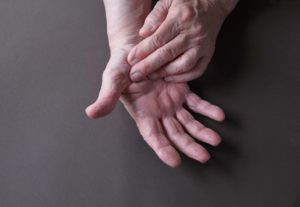
Football and basketball players know the feeling of a jammed finger all too well. You reach out to catch the ball, and instead of it landing perfectly in your palms, it crashes against the tip of your finger. Jamming your finger can also happen when you are around the house, like accidentally smashing the tip of your finger against a solid object. A jammed finger occurs suddenly and can surprise you with how much it can impact your daily routines. Some of the best orthopedic doctors will tell you how to fix a jammed finger properly. Here’s everything you need to know about how to treat a jammed finger so it can heal swiftly and effectively.
What Is a Jammed Finger?
A jammed finger refers to a blunt impact injury to the tip of the finger. This type of injury pushes the tip of the finger back toward the hand. The sudden impact of a jammed finger can overstretch or even tear the ligaments in the finger. The ligaments in each finger help connect the bones together that make up each finger. A sudden strain or tear of ligaments in one or more fingers can cause pain, stiffness, and swelling. If you jam your finger hard enough, it can actually lead to tendon damage or even a fractured finger. A jammed finger can range from mild to severe, and it is important to prevent any permanent damage by getting proper medical treatment.
Jammed Finger vs. Fractured Finger
A severely jammed finger can be mistaken for a fractured finger. A fracture is the medical term for a broken bone. If you break one of the bones in your fingers, it can cause similar symptoms. Common symptoms of a jammed finger include pain, redness, and swelling. You may also experience difficulty gripping or holding something with the jammed finger. However, with a fractured finger, the pain would be severe, and the swelling could last for days. A fractured finger would also prevent you from fully straightening or bending the finger. If you are unsure whether you have a jammed finger or a fractured finger, an orthopedic doctor can help.
Diagnosing a Jammed Finger
Visit an orthopedic doctor to diagnose an injury to one of your fingers. If you have mild to moderate pain and discomfort in the finger, then you may just be dealing with a jammed finger. Your doctor will want to know how the injury occurred and what symptoms you have been experiencing. In order to properly diagnose a jammed finger, your doctor will examine the finger for swelling and assess your movement. They will compare the injured finger to those around it, which helps determine the level of swelling. If you are able to bend and straighten your injured finger, then your doctor may be able to rule out a fractured finger. In severe cases, your doctor may also want to run diagnostic imaging tests like an X-ray or CT scan. These tools can help determine if you have a bone fracture or not. They can also provide your doctor with a more detailed look at any damage caused by the injury.
How to Fix a Jammed Finger
Your jammed finger treatment will depend on the severity of the injury. In some cases, a mildly jammed finger can be treated at home. In more serious cases, you will need to see an orthopedic doctor for the appropriate jammed finger treatment. Here are three aspects of how to treat a jammed finger so it can heal properly.
R.I.C.E.
R.I.C.E. stands for Rest, Ice, Compression, and Elevation. The first thing you want to do after a sudden injury is to rest the area. Avoid movements and activities that make your pain worse. Icing your finger can help reduce any swelling in the area. Wrapping your finger will also provide natural compression to the area, which also helps bring down swelling. Finally, elevating the finger above your heart helps reduce pain and swelling immediately after the injury.
Immobilization
Part of your treatment for a jammed finger will likely involve temporarily immobilizing the injured finger. You may be able to do this at home with a mild jammed finger, or an orthopedic doctor can help. One way to immobilize the jammed finger is called “buddy taping.” Buddy taping involves using medical tape to gently and securely strap the injured finger to the one next to it. You can also immobilize the finger using a splint made of metal or foam that helps keep your finger in place. You may need to have the finger immobilized for up to two weeks, depending on how long it takes the pain and other symptoms to go away.
Exercises
After the swelling has gone down and the jammed finger has healed, exercises can help you regain lost motion. Exercises to help strengthen the affected finger may include flexing your hand, making a fist, or squeezing and holding objects. In more serious cases of a jammed finger, your doctor may recommend physical therapy for your best chance at a full recovery. Simple stretches and strengthening exercises will provide you with gentle rehabilitation and prevent future injury.
Recovering from a Jammed Finger
A typical jammed finger can take 1 to 2 weeks to heal fully. It is best to avoid using your injured finger during the recovery process as much as possible. However, it is possible to experience swelling and discomfort in the affected finger for longer. Your finger may be sensitive to the touch, and certain sports and activities may exacerbate your pain and swelling. Talk to your doctor if your attempts to treat a jammed finger at home haven’t worked. If you notice any deformation or long-term pain and swelling around the finger joints, then visit an orthopedic doctor.
Visit the best orthopedic doctors in Atlanta at AICA Orthopedics. Our team of doctors will provide you with quality, comprehensive care for any injury and a personalized treatment plan to help you fully heal and recover.
